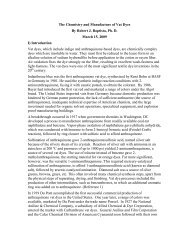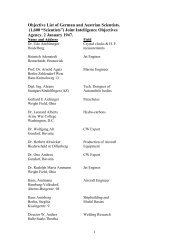International Dyestuff Industry - ColorantsHistory.Org
International Dyestuff Industry - ColorantsHistory.Org
International Dyestuff Industry - ColorantsHistory.Org
You also want an ePaper? Increase the reach of your titles
YUMPU automatically turns print PDFs into web optimized ePapers that Google loves.
Herbert Levinstein, son of Ivan, acquired the sequestered Hoechst indigo factory at<br />
Ellesmere Port. There he manufactured phenylglycine from aniline, and indigo became<br />
available from 1916 in sufficient amounts to satisfy the Scottish and Lancashire printers and<br />
dyers. [48] The demand for military uniforms was met. (The BASF factory at Birkenhead<br />
was sold to Colonel E. A. Brotherton of Leeds.)<br />
Dye-makers had other major strategic roles: they were leading suppliers of nitro<br />
compounds for explosives, and, from 1915, chemicals used in gas warfare. Consequently,<br />
consolidation was encouraged by the British government. Read Holliday had close links with<br />
the Bradford Dyers' Association, especially an important contract for supply of sulfur blacks.<br />
It did not take much government persuasion for Read Holliday to merge with the Bradford<br />
Dyers' Association and the Calico Printers' Association to form British Dyes Ltd. in 1914 (the<br />
prospectus was published in March 1915). However, immediately after the war considerable<br />
government persuasion, with help from the newly formed Colour Users Association (1919),<br />
was required to bring the rival Read Holliday and Levinstein interests together in May 1919.<br />
At that time the British <strong>Dyestuff</strong>s Corporation, Ltd. came into being, a merger of the<br />
Huddersfield-based British Dyes and the Manchester-based Levinstein Ltd. Another branch<br />
of the Holliday family, L.B. Holliday & Co. Ltd., was set up in 1916 in Huddersfield, and this<br />
remained independent.<br />
From the start of hostilities, the French government had supported moves for<br />
self-sufficiency. The major manufacturer in 1914 was Societe Colorantes et Produits<br />
Chimiques de Saint-Denis, Pointer's old firm. The important Hoechst and BASF factories<br />
were taken over by the government. In 1917, through the Service de Poudres, the<br />
government assisted in the creation of the Compagnie Nationale des Matieres Colorantes et<br />
Produits Chimiques, near Rouen, which employed 2,000 workers, and which produced<br />
synthetic indigo on a large scale from 1921.<br />
The absence of German products encouraged manufacture in European countries that had<br />
previously not been involved in the dye industry. The first Italian factory, Industria<br />
Nazionale Colori di Anilina, was opened in Milan during 1915 with assistance from<br />
Manchester's Claus & Co. Ltd. (which was taken over by Levinstein in the following year),<br />
and specialized in sulfur, azo and triphenylmethane dyes. The Spanish industry was<br />
concentrated in Catalonia, where in Barcelona J. Pellicier and L. Sangier were joined by the<br />
Sociedad Espanola de Productos Quimicos.<br />
In Russia, where in 1913 some ten firms, some foreign-owned, produced around 8,000 tons<br />
of dyes, and one-quarter of all imports arrived from Britain, there were severe shortages<br />
from 1914. This forced the dyers and printers to take action, producing sulfur, phenol and<br />
naphthalene dyes.<br />
But it was across the Atlantic that the greatest transformation took place. In 1914 the<br />
United States dye manufacturers relied heavily on imported German intermediates, and the<br />
dyers and printers on German colorants, despite the 30 percent ad valorem duty.<br />
Schoellkopf (then known as the Schoellkopf, Hartford & Hanna Co., specializing in azo dyes<br />
and sulfur and direct blacks) and Heller & Merz together produced no more than 12 per cent<br />
of dyes consumed by the domestic market. With the outbreak of war, there were shortages<br />
and the price of dyes increased considerably. There was a surge in demand for natural<br />
dyes, notably Brazilwood (redwood), logwood and fustic. Bayer's interests alongside the<br />
Hudson were seized and sold to Sterling Products that was mainly interested in the<br />
pharmaceutical division. The dye-making facilities were purchased by the Grasselli Chemical<br />
Co., that operated a dye factory at Linden, New Jersey, in 1919.<br />
Home based production was encouraged by the Revenue Act, of 18 September 1916, which<br />
provided a protective barrier for a period of five years. In 1915, Herbert Dow had started<br />
work on indigo, and by the end of 1916 the first American-made artificial indigo was<br />
available from the Dow factory at Midland, Michigan. Calco Chemical Company, at Bound<br />
Brook, NJ, was founded in 1915 and immediately began to produce intermediates. One year<br />
later the Federal <strong>Dyestuff</strong> Corporation of Kingsport, Tennessee was opened, and became a<br />
major producer of sulfur blacks.





